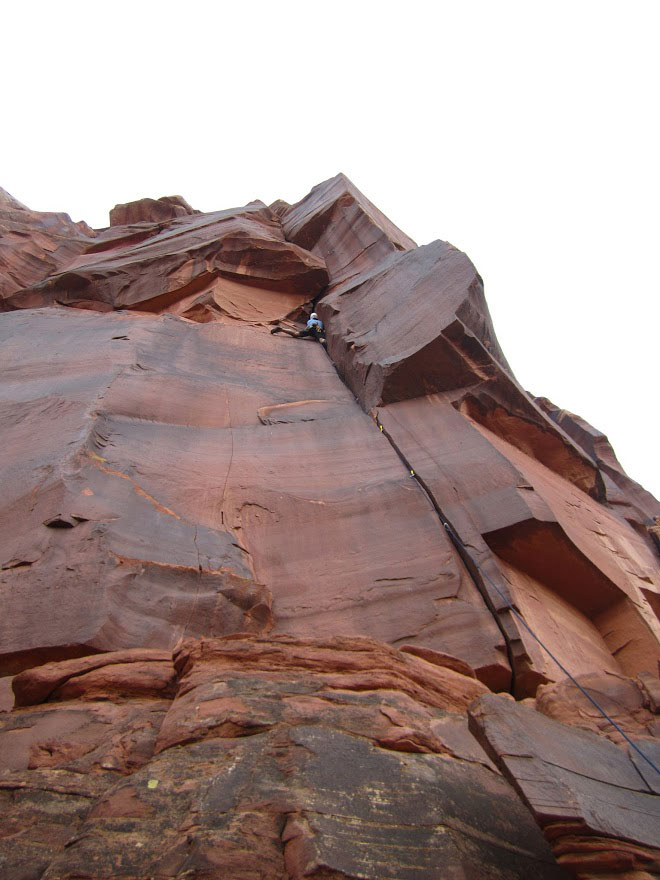A while back, we had a discussion here at BLISTER about working up a Climbing 101 article about cams. There’s a lot of information and nuance out there when it comes to differences between brands and models, and we thought an overview would be helpful for those looking to make their first cam purchases.
When it comes time to make that first purchase, however, chances are you’ve already had some experience with cams and therefore some working knowledge of them, since most trad climbers are introduced to the use of cams through their peers. Unlike snowboarding, say, where a total beginner might pick up a used board and dive right into the sport largely by themselves, traditional climbing often involves an apprenticeship of sorts. (After all, adequately protecting a route using traditional methods is a complex, nuanced skill in a setting where the penalty for mistakes can be extremely high.)
This oral tradition creates a rich culture around traditional climbing, but one in which most people learn to climb by placing their partner’s gear. Often times, then, a climber will have become accustomed to whichever brand/s or type of gear they learned on, instilling taste, preference, or even a strong bias before their first cam is purchased.
So rather then spend time explaining what cams are, their basic components (lobes, stem, trigger, etc.), and how they function, this article assumes you already have this working knowledge and have, at minimum, followed a trad leader (and cleaned the gear along the way), possibly even having placed protection yourself. (Note this is not a substitute for proper instruction, and anyone looking to break into traditional climbing is strongly encouraged to enroll in a course or seek out a trusted mentor). Instead, we thought most climbers would be better served by a discussion on things to consider when standing in front of a wall of cams at your local shop.
And for those who don’t yet have a working knowledge of cams, we’ve also created Climbing 101: Cam Glossary that ought to be useful.
There’s certainly nothing wrong with buying what you know. After all, how well a cam model suits you is often dictated as much by preference as by objective design characteristics. But certain cams are best suited to certain types of climbing (style, location, rock type, etc.) and marrying your gear to your style of climbing is your best bet for getting the right piece the first time.
These considerations also engage the decisions confronted by more experienced climbers, as when buying doubles or triples in your most commonly used sizes. Is it best to double up with what you’re familiar with or diversify your rack? Hopefully these ideas help elucidate that choice.
Desert Rats
The red stone in the American southwest is marbled with deep, laser-cut, parallel-sided cracks. For these types of cracks, most any cam will work because many issues like head width, etc. are not important. These placements are typically straightforward, textbook placements for which any style of cam will work just fine. It is nice to have more surface area on the cam lobes to prevent damaging the soft rock, but from the standpoint of safety, any cam that fits will work so long as you are not climbing after a recent rainstorm.

Many of the classic desert splitters (such as 4×4 at Indian creek) slowly widen or taper as the pitch progresses. For climbs such as these, it’s nice to have a few different kinds of cam so that the sizes overlap to some degree. While you can make do with the same brand, if you climb a lot in the desert and need to flesh out your rack, you might think about supplementing your C4s with Helium Friends, or vice versa rather than doubling up on what you already own. The desert has tended to reward diversity, in my experience.


While not related to cams, I have a Climbing 101 type question: How do you stop climbing shoes from stinking? Perhaps there is a whole article in this?
Keep up the good work, great site.
Nick
Nick,
Thanks for the feedback and encouragement amigo! Regarding shoe smell, there are a lot of opinions on this and what works best, but some of it comes down to what your shoes are made out of. Leather is going to be different than shoes lined with, say, cotton, both of which are better, in my experience, than synthetics. So, some shoes work against you in regard to smell.
My shoes aren’t terrible, so I don’t go to greater lengths than trying to be good about letting them air-dry (keeping them out in my car rather than stuffed in a pack for days after climbing), and storing them in a non-airtight place. However, I’ve heard of a million home remedies for this (though admittedly often in the context of regular street shoes, though I’m sure they’d work just as well/poorly for climbing shoes) including, but not limited to, freezing your shoes (to kill the bacteria that cause odor), washing your feet before climbing when possible, gold bond (or any other garden variety foot-odor product marketed for regular shoes), wearing thin socks, etc.
There’s definitely more discussion about this on both mountainproject.com and supertopo.com (just search the forums) though I suspect you might have to make a list of ideas and go through them systematically until you find something that works. Either way, be sure to let us know what does and doesn’t work when you start taking a crack at it!
Good luck man,
Dave
Thanks Dave, I’ll report back – although my shoes are starting to fall apart so I might start with some fresh ones and take preventative measures.
Cheers
Nick